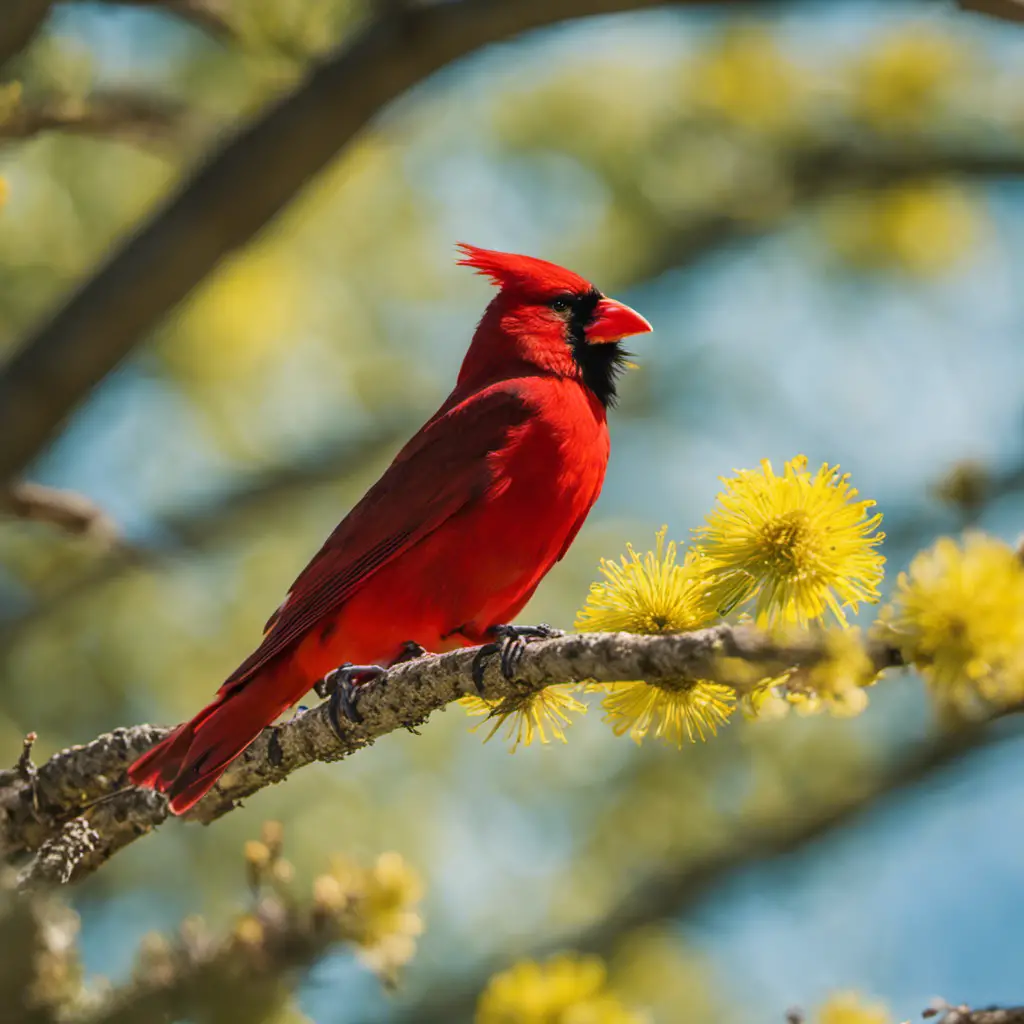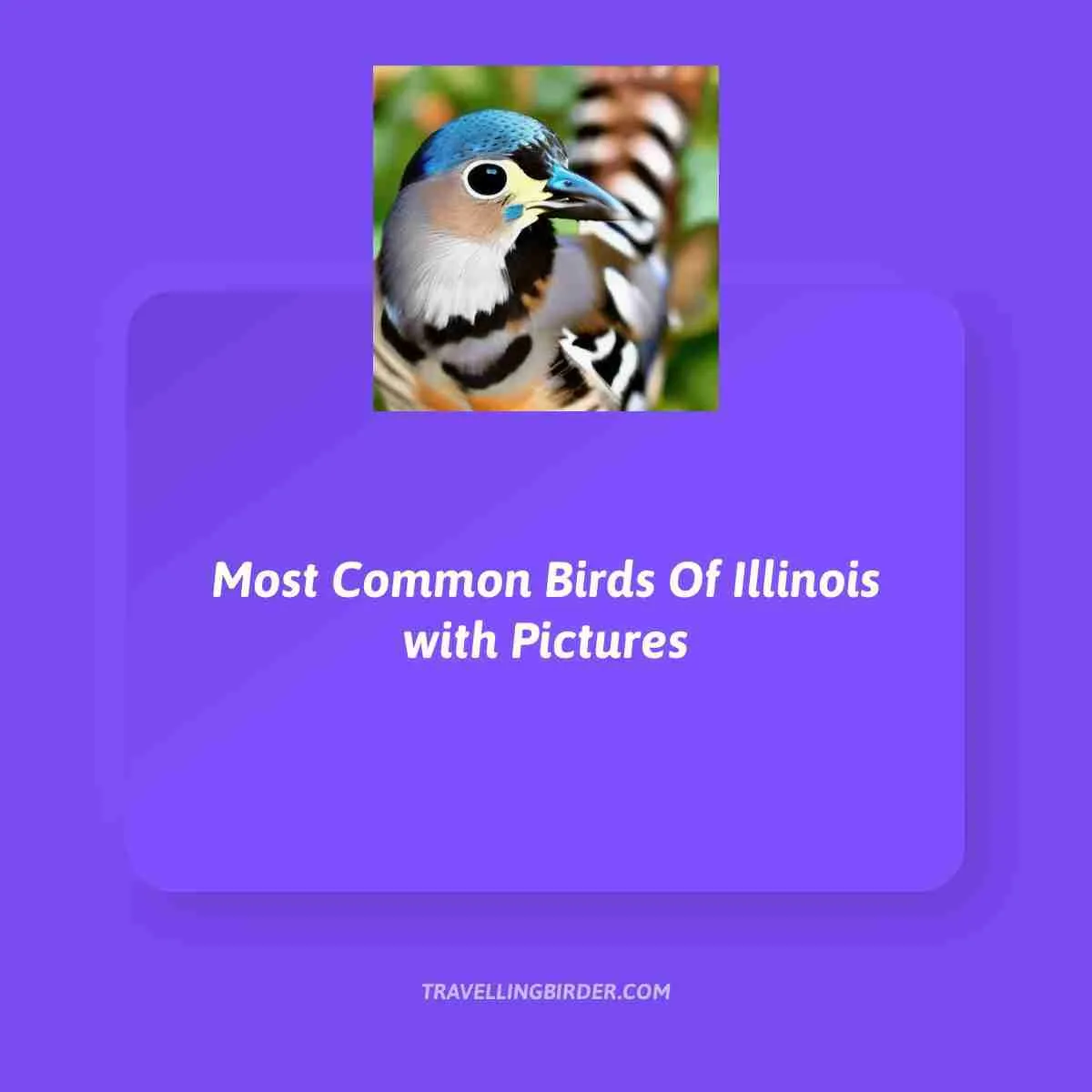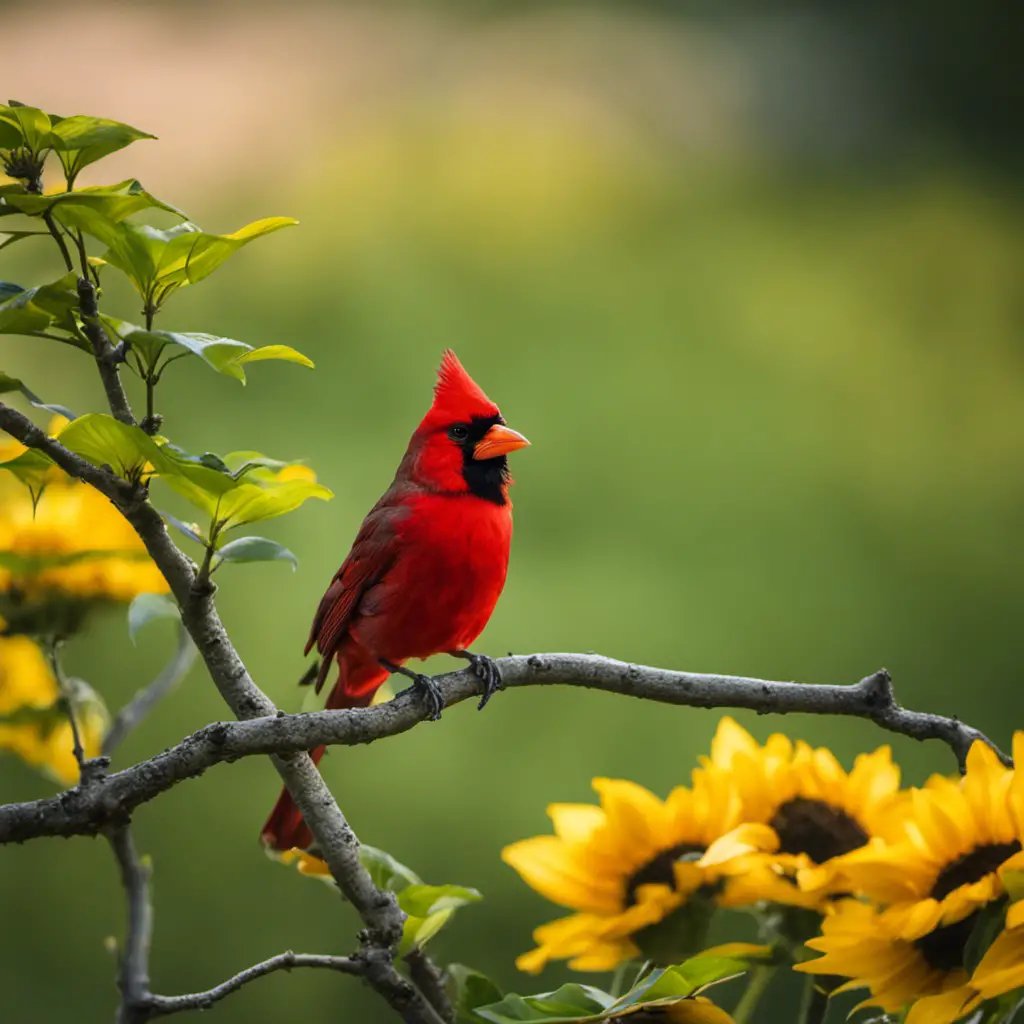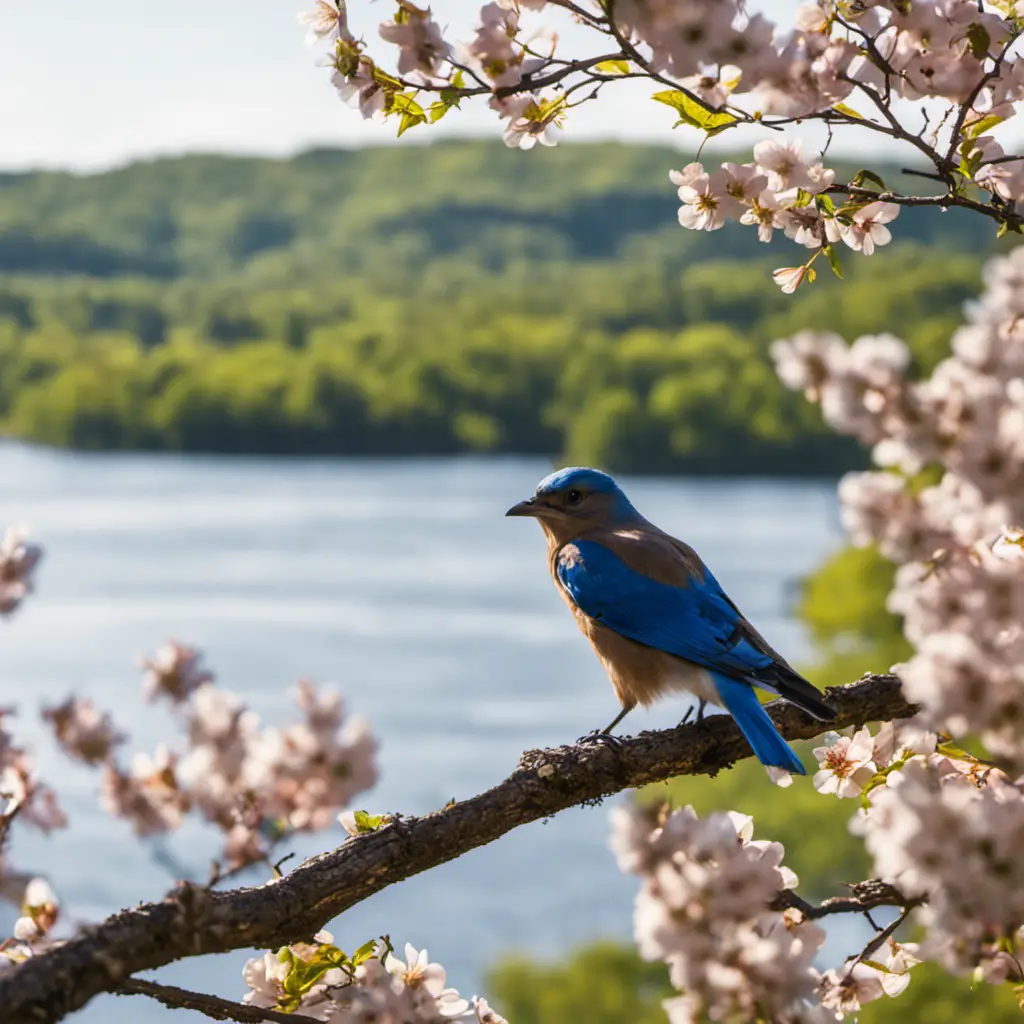If you’re interested in the diverse avian species found in Iowa, you’re in for a treat. Iowa boasts a wide array of birds, each with its own unique characteristics and behaviors. From the vibrant plumage of the American Robin to the striking call of the Red-winged Blackbird, these feathered creatures captivate the senses.
Join us as we delve into the fascinating world of Iowa’s birds, exploring their habitat, migration patterns, and intriguing adaptations. Get ready to be amazed by the natural wonders that call Iowa home.
Key Takeaways
- Native birds of Iowa include the American Robin, Northern Cardinal, Red-winged Blackbird, and Mourning Dove.
- Introduced and invasive birds in Iowa include the House Sparrow and European Starling, which have negative impacts on native bird populations.
- Birds with vibrant plumage in Iowa include the American Goldfinch, Blue Jay, and Cedar Waxwing.
- Water birds commonly found in Iowa include the Mallard, Canada Goose, and Belted Kingfisher.
American Robin
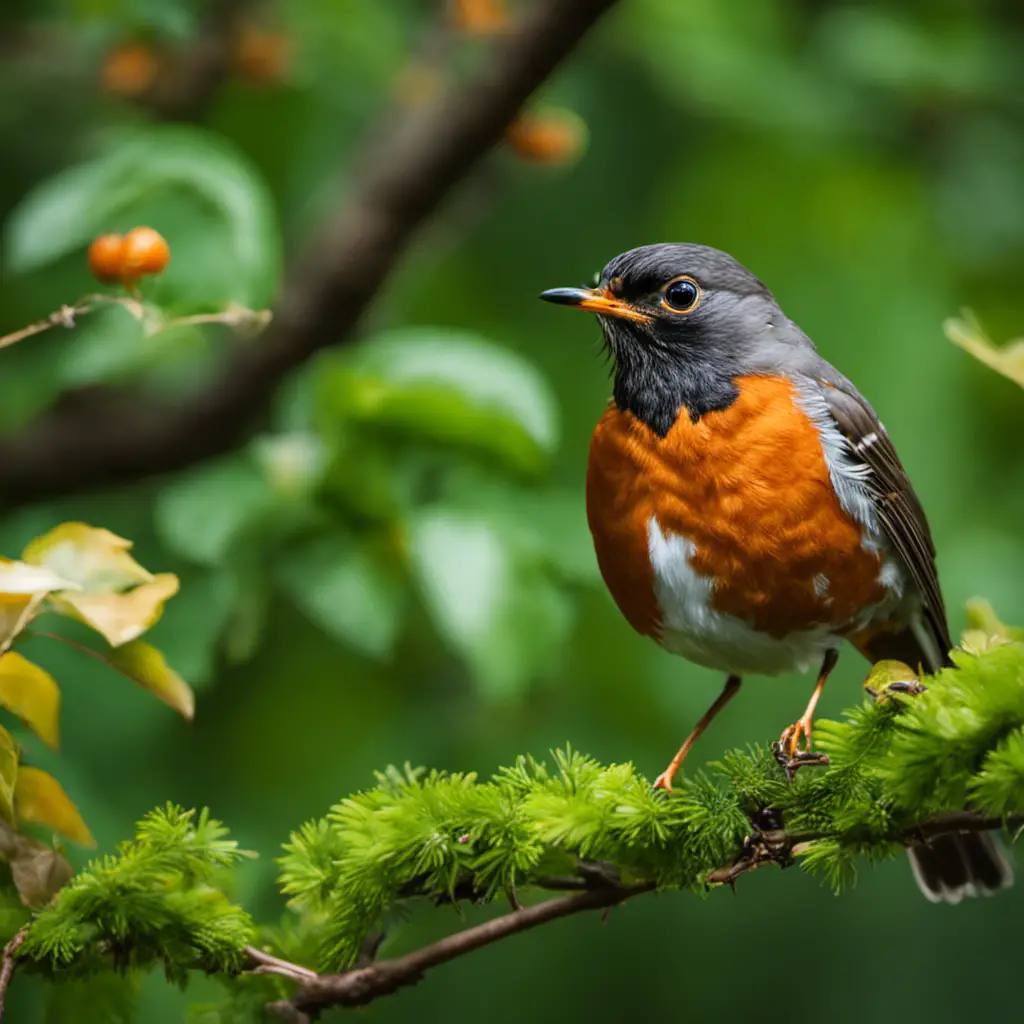
You should watch out for the American Robin nesting in your backyard.
The American Robin, scientifically known as Turdus migratorius, is a common sight in North America, including Iowa. These birds are known for their distinct reddish-orange breast and gray-brown back.
When it comes to nesting, American Robins prefer to build their nests in trees or shrubs, using materials such as grass, twigs, and mud.
Their diet consists mainly of insects, earthworms, berries, and fruits.
In terms of migration patterns, American Robins are known to be partially migratory, with some individuals staying in their breeding grounds and others migrating south during the winter months.
Conservation efforts for the American Robin focus on preserving their natural habitats, reducing pesticide use, and promoting the planting of native trees and shrubs that provide food and shelter for these birds.
Northern Cardinal
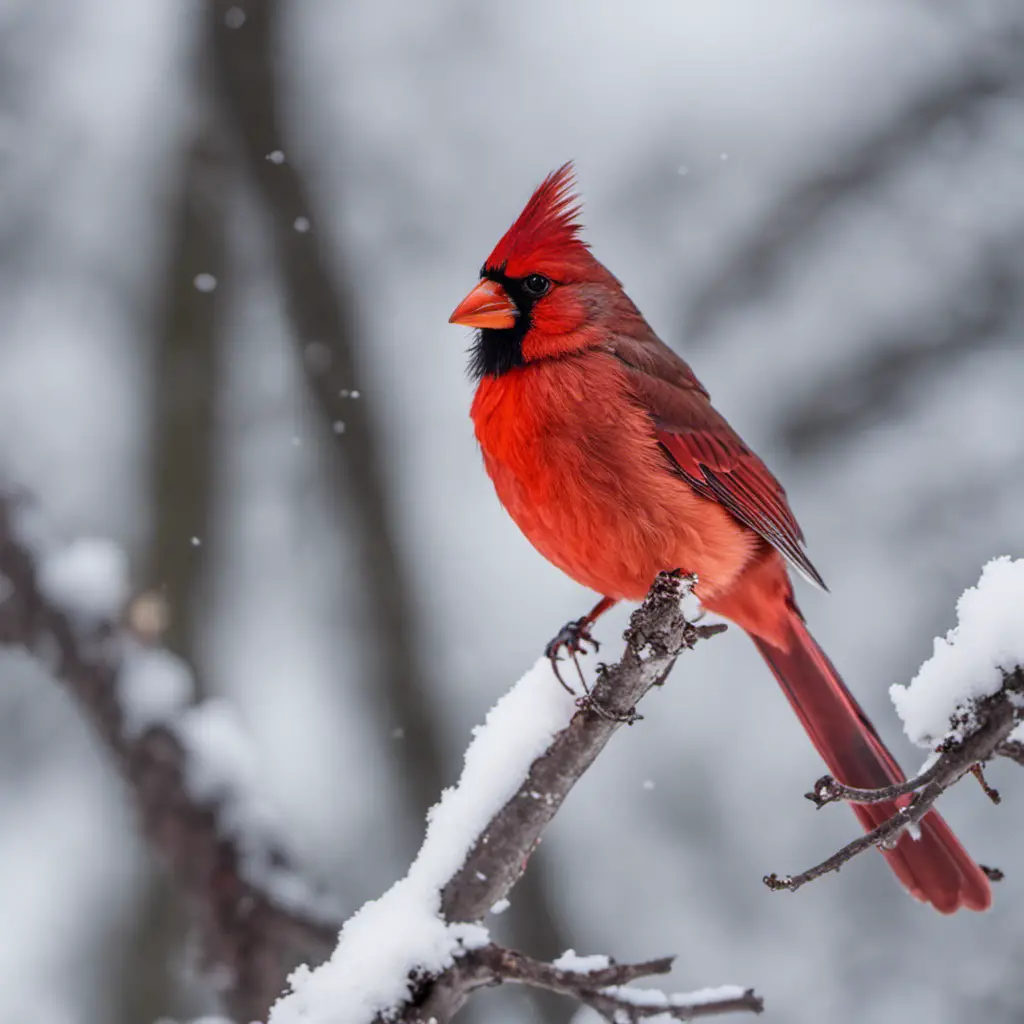
The Northern Cardinal is a common bird species in Iowa known for its vibrant red plumage. This beautiful bird is a favorite among birdwatchers and nature enthusiasts. Let’s explore the behavioral patterns, habitat, and nesting preferences of the Northern Cardinal:
Behavioral patterns:
Male cardinals are known for their territorial behavior, often defending their territory through song and aggressive displays.
They’re primarily seed eaters but also consume insects and fruits.
Cardinals are known for their distinctive song, which is often described as a series of clear, whistled notes.
Habitat:
Cardinals can be found in a variety of habitats, including woodlands, forests, and suburban areas.
They prefer areas with dense vegetation and shrubs for nesting and hiding.
Nesting preferences:
Cardinals build their nests in dense shrubs or low trees, usually a few feet above the ground.
The female cardinal builds the nest, which is a cup-shaped structure made of twigs, grass, and leaves.
Cardinals typically lay 2-5 eggs and incubate them for about two weeks.
House Sparrow

Let’s delve into the fascinating world of House Sparrows and learn about their nesting habits while exploring their adaptability to urban environments.
House Sparrows, also known as Passer domesticus, are small, social birds that are native to Europe, Asia, and North Africa. They’ve successfully established populations in urban areas around the world, including North America. House Sparrows are highly adaptable and can be found in a variety of habitats, including cities, suburbs, farmlands, and open woodlands.
They typically build their nests in crevices, such as tree cavities, buildings, and nest boxes. Their nests are made of grass, feathers, and other plant materials.
However, their adaptability and ability to thrive in urban environments have raised concerns about their impact on native bird populations. Studies have shown that House Sparrows can outcompete native species for resources such as food and nesting sites, leading to a decline in their populations.
Understanding the behavior and habitat of House Sparrows is important for managing their populations and mitigating their impact on native bird species.
Red-winged Blackbird
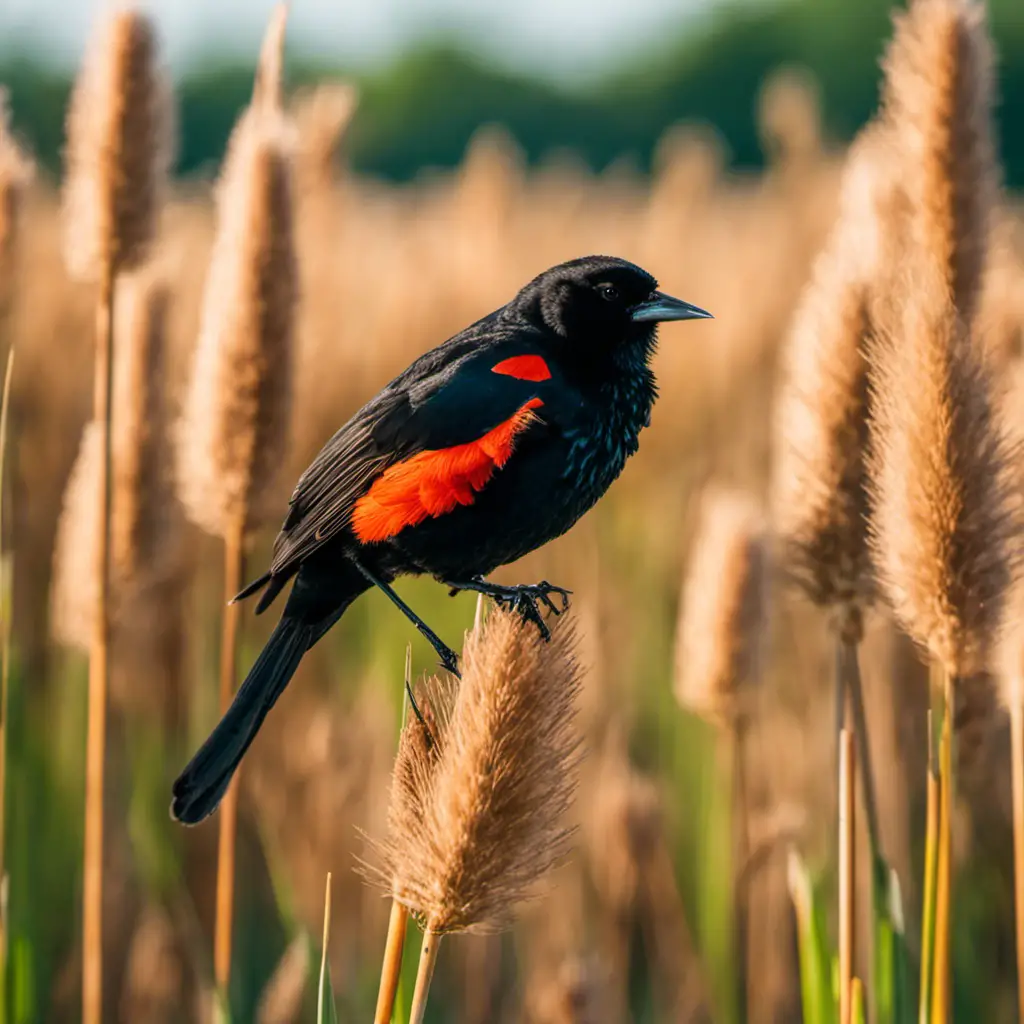
Sometimes, you can spot Red-winged Blackbirds perched on cattails or singing their distinct song. These birds are commonly found in wetland habitats such as marshes, swamps, and reed beds. They prefer areas with dense vegetation where they can build their nests and find food.
Red-winged Blackbirds are known for their territorial behavior during breeding season. The males defend their nesting territories by displaying their red shoulder patches and singing loudly to attract females. They build cup-shaped nests made of grasses and cattails, usually close to the ground or in shrubs.
Once the female lays the eggs, both parents take turns incubating them. After the eggs hatch, the parents work together to feed and care for the chicks until they fledge. Red-winged Blackbirds are fascinating birds to observe, especially during the breeding season when their behaviors are at their most active and vibrant.
Mourning Dove

You can hear the mournful cooing of Mourning Doves in the early morning as they perch on telephone wires. These small, gray birds are a common sight in Iowa and are known for their gentle and soothing calls. Let’s take a closer look at the mating habits and diet of the Mourning Dove.
| Mourning Dove’s Mating Habits | Mourning Dove’s Diet and Feeding Behavior |
|---|---|
| Mourning Doves form monogamous pairs, with both parents participating in nest building and care for the young. | Mourning Doves primarily feed on seeds and grains, such as corn, wheat, and millet. They also eat small insects and snails. They forage on the ground, using their beaks to pick up food. |
| During courtship, the male Mourning Dove performs a display flight, flying in a circular pattern and making sharp turns while producing a distinctive "whistling" sound. | These birds are ground feeders and often visit bird feeders for supplemental food. They can be attracted to feeders with sunflower seeds, cracked corn, and millet. |
Understanding the mating habits and feeding behavior of the Mourning Dove provides insight into their ecological role as seed dispersers and their importance in maintaining a balanced ecosystem.
American Goldfinch
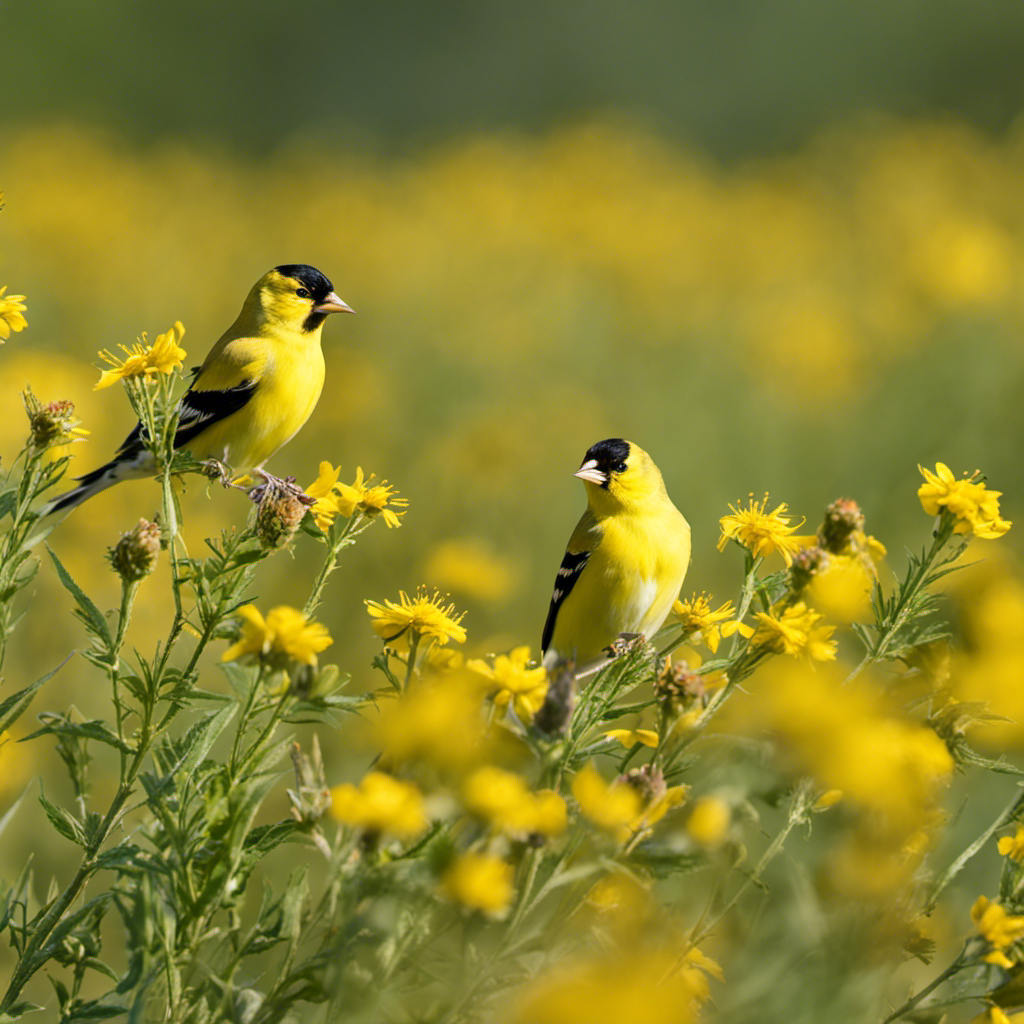
The American Goldfinch is a small, brightly colored bird that can be commonly found in Iowa during the summer months. This species, scientifically known as Spinus tristis, is characterized by its vibrant yellow plumage, contrasting with black wings and a black cap.
Its habitat preferences include open fields, meadows, and grasslands with scattered trees, where it can find its preferred food sources such as seeds from various plants.
During breeding season, American Goldfinches exhibit interesting behaviors. The males perform an elaborate courtship display, flying in an undulating pattern while singing a distinctive, sweet song. Once a pair forms, the female builds a cup-shaped nest in a shrub or tree, often using plant fibers and spider silk.
The female then lays a clutch of 3-7 pale blue eggs, which she incubates for about 12-14 days.
Blue Jay
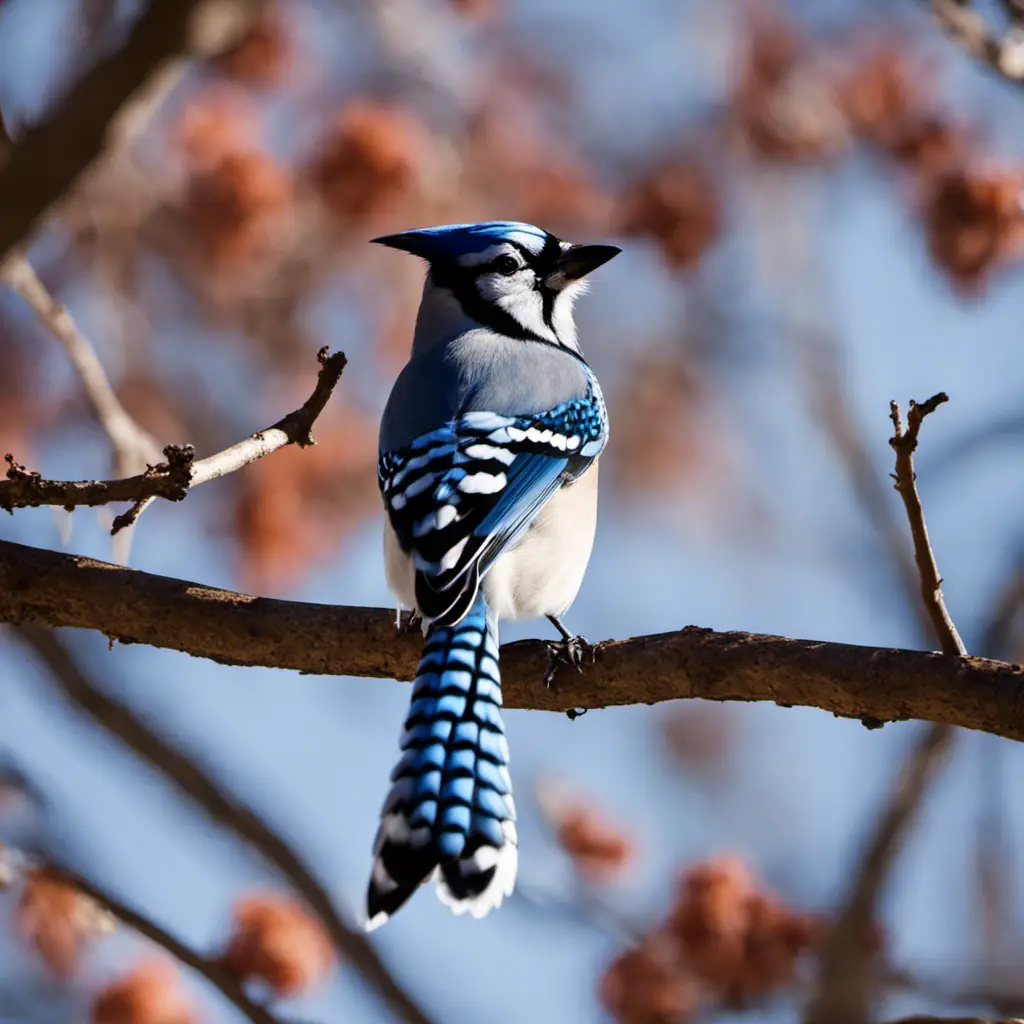
You can frequently spot a noisy Blue Jay in your backyard, boldly perched on a branch. Blue Jays, scientifically known as Cyanocitta cristata, are native to North America and are easily recognizable due to their vibrant blue feathers and distinctive crest on their heads. These birds exhibit fascinating behavioral patterns and have specific habitat and nesting preferences. Blue Jays are highly intelligent and social birds, often seen in small family groups or larger flocks. They are known for their loud, raucous calls and mimicry skills. When it comes to nesting, Blue Jays prefer deciduous and mixed woodlands, building their nests on tree branches or in thick shrubs. They construct sturdy nests using twigs, grass, and other plant materials, and both male and female Blue Jays take part in nest building. Understanding the behavioral patterns and habitat preferences of Blue Jays can help us appreciate these beautiful birds and create suitable environments for their survival.
| Behavioral Patterns | Habitat and Nesting Preferences |
|---|---|
| Highly intelligent | Deciduous and mixed woodlands |
| Social birds | Tree branches or thick shrubs |
| Loud, raucous calls | Sturdy nests using twigs, grass, and plant materials |
| Mimicry skills | Both male and female participate in nest building |
Downy Woodpecker
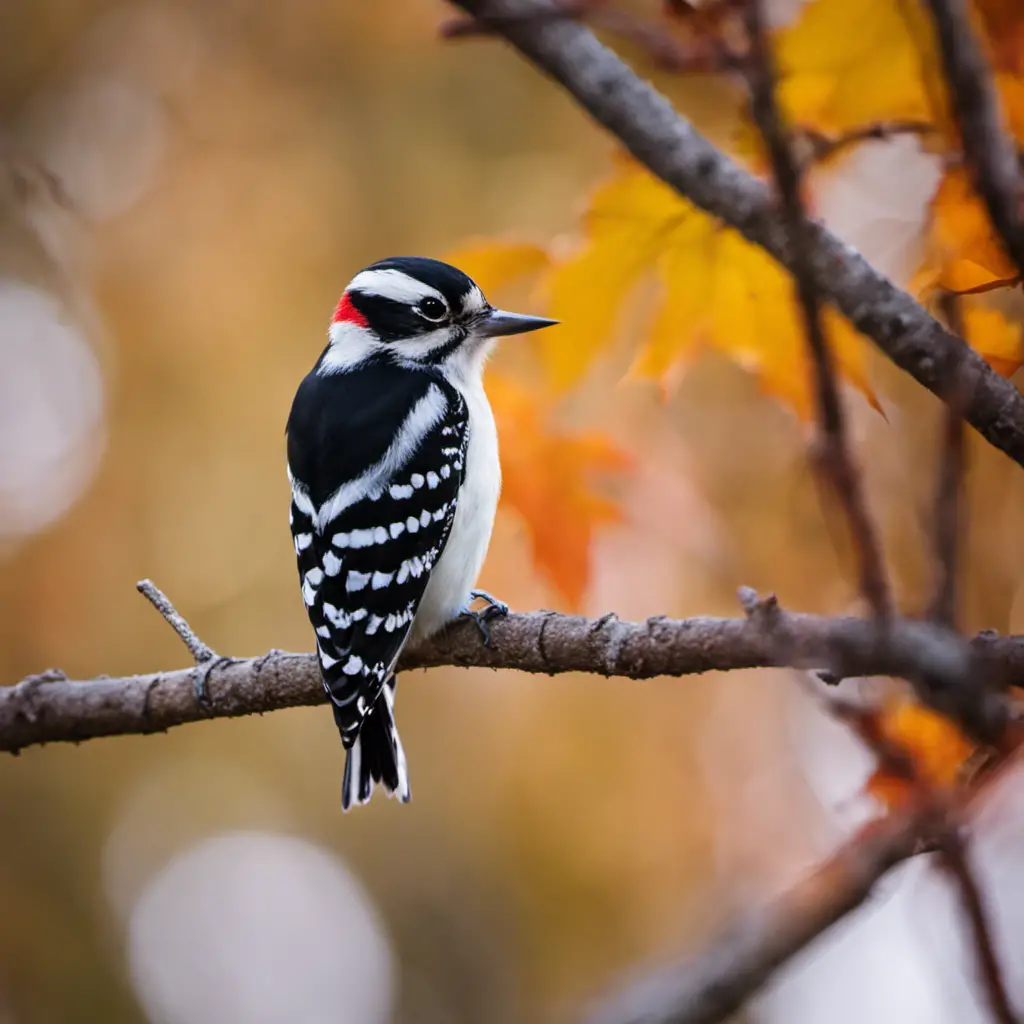
Spotting a Downy Woodpecker can be challenging, but they’re commonly found in woodlands and urban areas. These small birds, measuring around 6.5 inches in length, have distinct black and white plumage with a small red patch on the back of their heads.
When it comes to behavior patterns, Downy Woodpeckers are known for their drumming, which they use to communicate with other woodpeckers and establish territory. They’ve a unique feeding habit, using their sturdy beaks to excavate small holes in tree trunks in search of insects and larvae.
As for their habitat, Downy Woodpeckers prefer deciduous forests, orchards, and even suburban gardens with mature trees. Their diet mainly consists of insects, seeds, berries, and tree sap.
European Starling
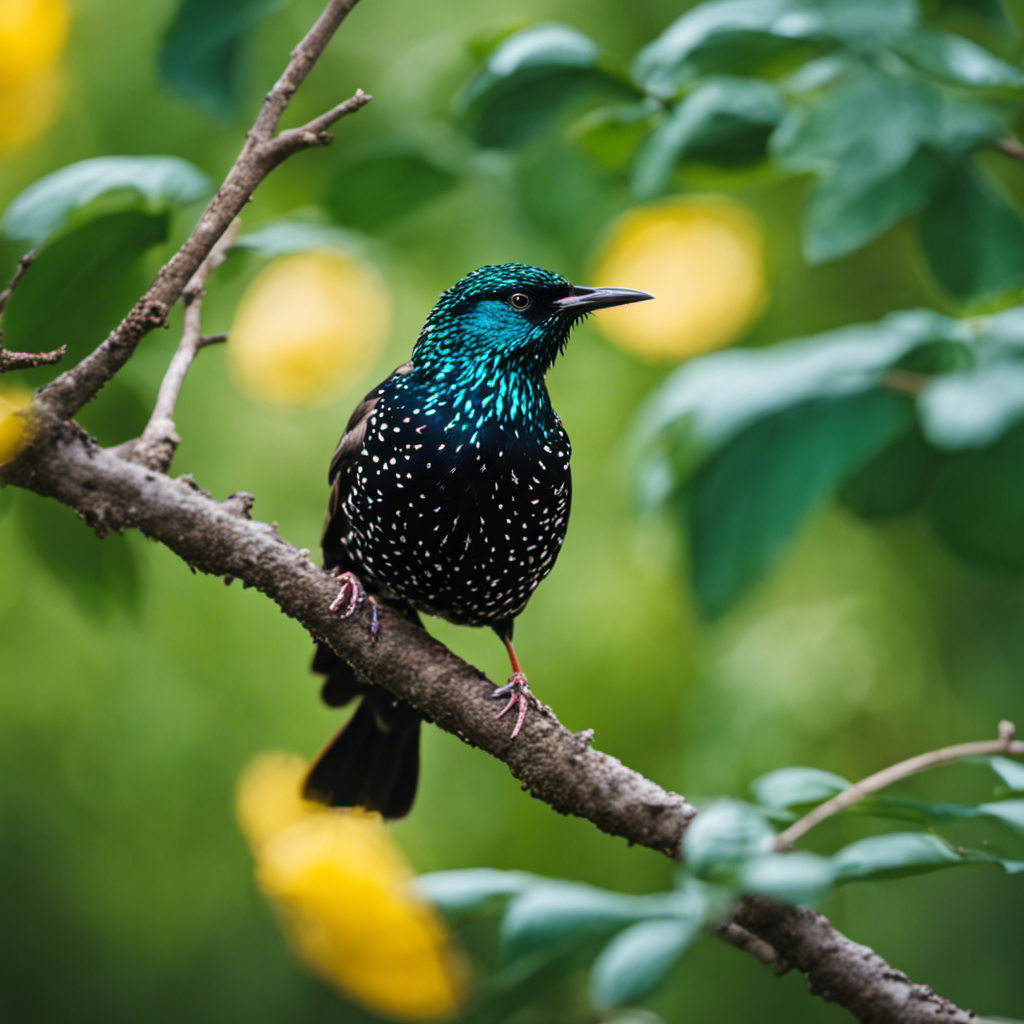
Have you seen a European Starling in your backyard recently? These birds, native to Europe, were introduced to North America in the 19th century and have since spread across the continent.
Unfortunately, their rapid expansion has had a significant impact on native bird populations. European Starlings are aggressive competitors for nesting sites and food, often displacing native species such as bluebirds and woodpeckers. They’re also known to outcompete other species for cavity nest sites, which can limit the availability of nesting habitat for native birds.
Furthermore, European Starlings are considered an invasive species due to their ability to rapidly reproduce and adapt to different environments. This has allowed them to successfully colonize many regions, disrupting local ecosystems.
Understanding the impact of European Starlings on native bird populations is crucial for developing effective conservation strategies to protect our native species.
Black-capped Chickadee
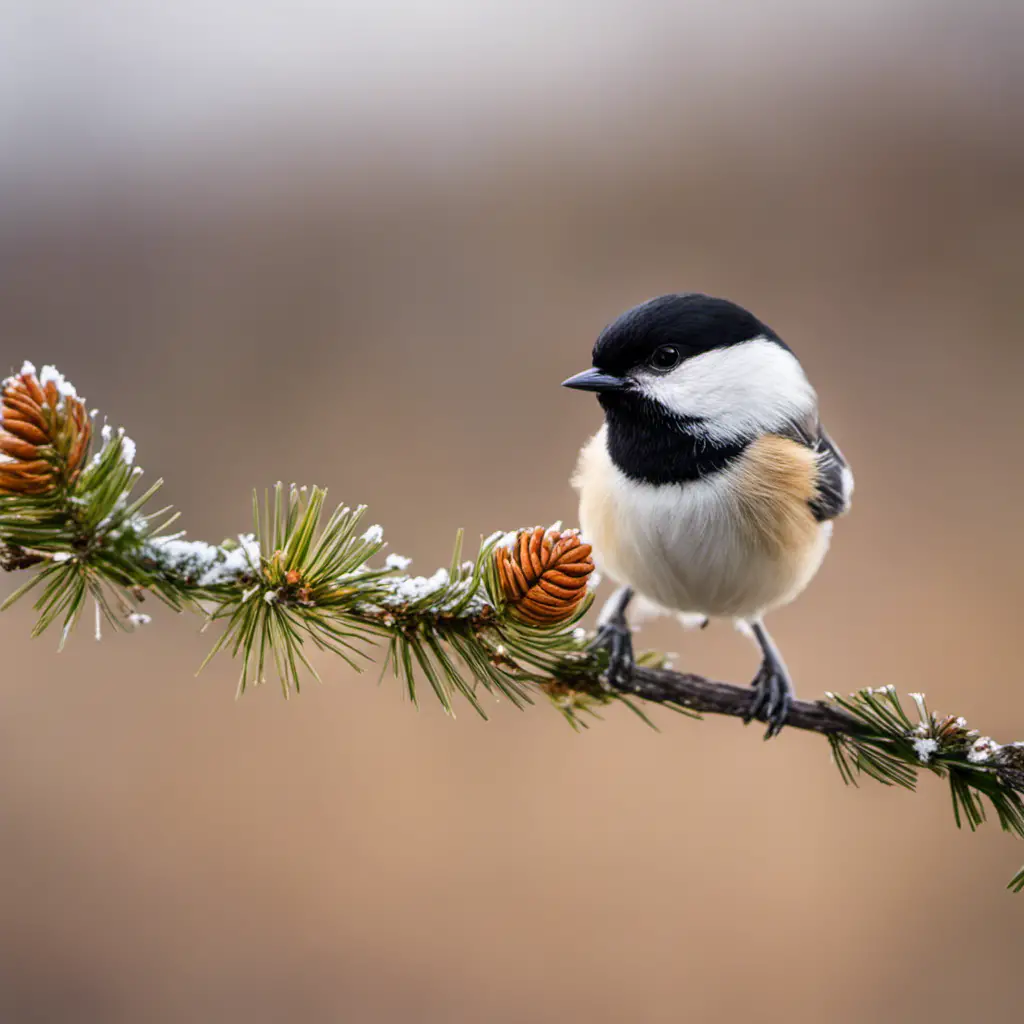
Do you know that Black-capped Chickadees are known for their distinctive call that sounds like ‘chick-a-dee-dee-dee’? These small, non-migratory birds can be found across North America, including in Iowa. They inhabit a variety of forested habitats, including deciduous and mixed forests, as well as urban and suburban areas.
Black-capped Chickadees are highly social and form flocks during the winter months, often joining mixed-species foraging flocks. They’ve a diverse diet, feeding on insects, seeds, and berries. Conservation efforts for Black-capped Chickadees primarily focus on protecting and restoring their natural habitats, as well as providing nest boxes and supplemental food sources during winter.
These efforts aim to maintain and enhance the population of this charismatic bird species in Iowa and beyond.
House Finch
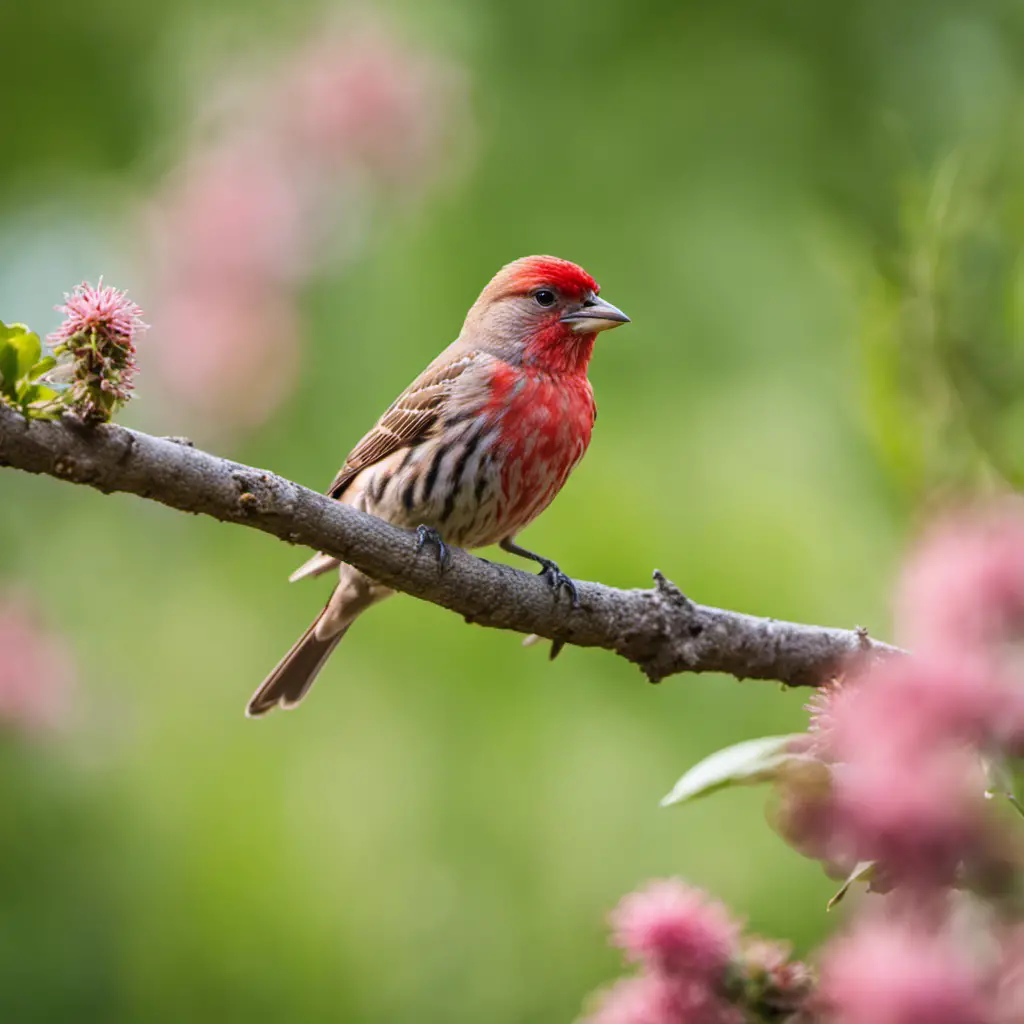
You can easily identify the House Finch by its vibrant red plumage and distinctive songs. These small passerine birds are commonly found across North America, including Iowa.
When it comes to breeding habits, House Finches are monogamous, forming pairs that mate for a single breeding season. They typically build their nests in shrubs, trees, or even man-made structures.
As for their diet and feeding behavior, House Finches primarily consume seeds, berries, and fruits. They’ve a unique feeding technique called ‘gaping,’ where they use their beaks to pry open tough fruits and access the nutritious insides. Additionally, House Finches are known to visit bird feeders, where they can be seen enjoying sunflower seeds and other seed mixes.
Overall, the House Finch is a fascinating bird to observe, with its vibrant appearance and interesting behaviors.
Eastern Bluebird
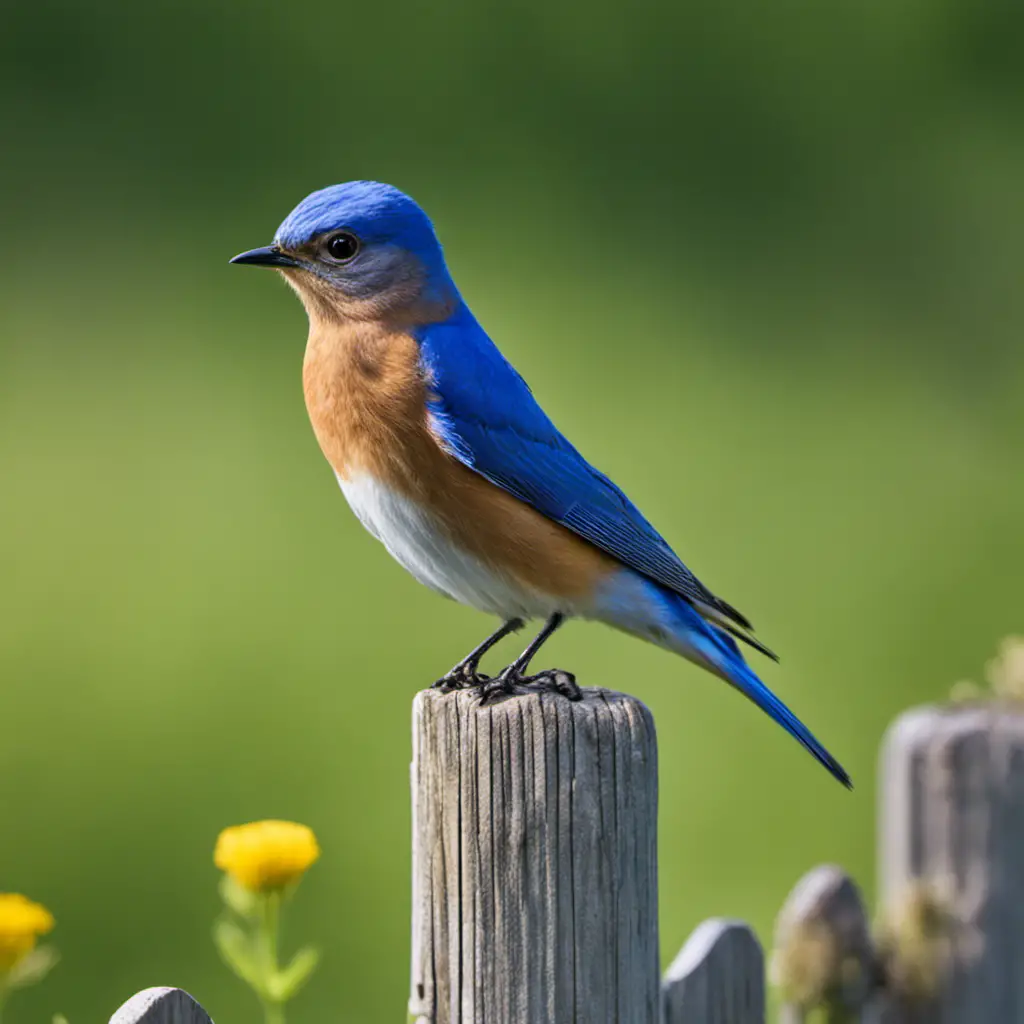
If you’re lucky, you might spot a pair of Eastern Bluebirds nesting in your backyard this spring. These stunning birds are known for their vibrant blue feathers and cheerful song. Eastern Bluebirds have specific habitat preferences and nesting behaviors that contribute to their survival and reproductive success. Here are some key points to understand:
Habitat Preferences:
Eastern Bluebirds prefer open areas with scattered trees and shrubs.
They’re often found in fields, meadows, and open woodland edges.
Bluebirds require nest boxes or natural cavities for breeding.
Nesting Behavior:
Eastern Bluebirds are cavity nesters, meaning they nest in tree cavities or man-made nest boxes.
They build cup-shaped nests using grasses, pine needles, and feathers.
Bluebirds typically lay 3-7 pale blue eggs and incubate them for about two weeks.
Understanding the habitat preferences and nesting behavior of Eastern Bluebirds can help you create an inviting environment for these beautiful birds in your backyard.
White-breasted Nuthatch
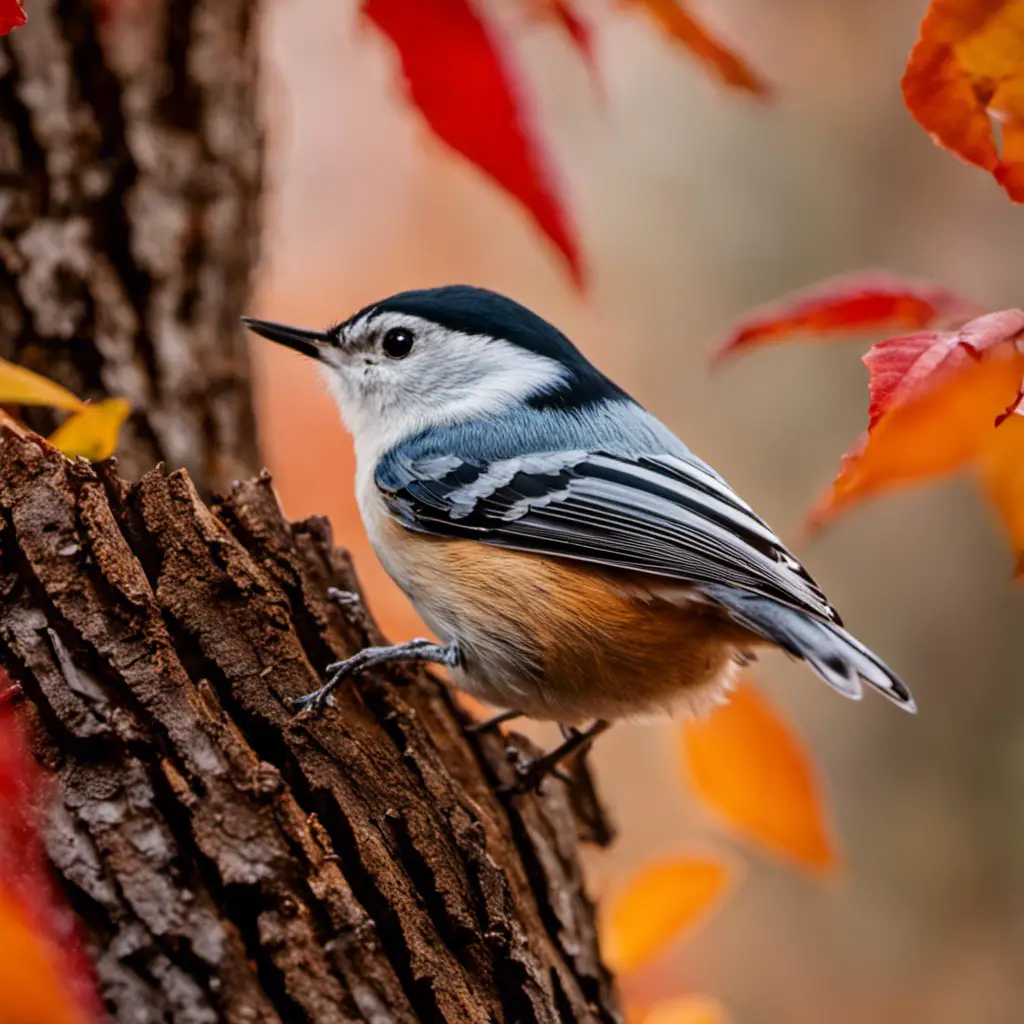
The White-breasted Nuthatch is a small songbird with a distinct black cap and white belly that you might see hopping up and down tree trunks in search of insects and seeds. This species can be found in various habitats across North America, including forests, woodlands, and suburban areas. White-breasted Nuthatches have unique behavioral patterns that make them stand out. They are known for their ability to climb down tree trunks headfirst, a behavior called "trunk creeping." They have a habit of caching food in tree bark, often wedging seeds or insects into crevices for later consumption. When it comes to nesting, White-breasted Nuthatches prefer to excavate their own cavities in dead trees or use existing cavities. They line their nests with bark, grass, and feathers for insulation. Overall, this species exhibits fascinating behavioral patterns and shows adaptability in their choice of habitat and nesting preferences.
| Behavioral Patterns | Habitat and Nesting Preferences |
|---|---|
| Trunk creeping | Forests, woodlands, suburban areas |
| Food caching | Excavate own cavities or use existing ones |
| Line nests with bark, grass, and feathers |
Mallard
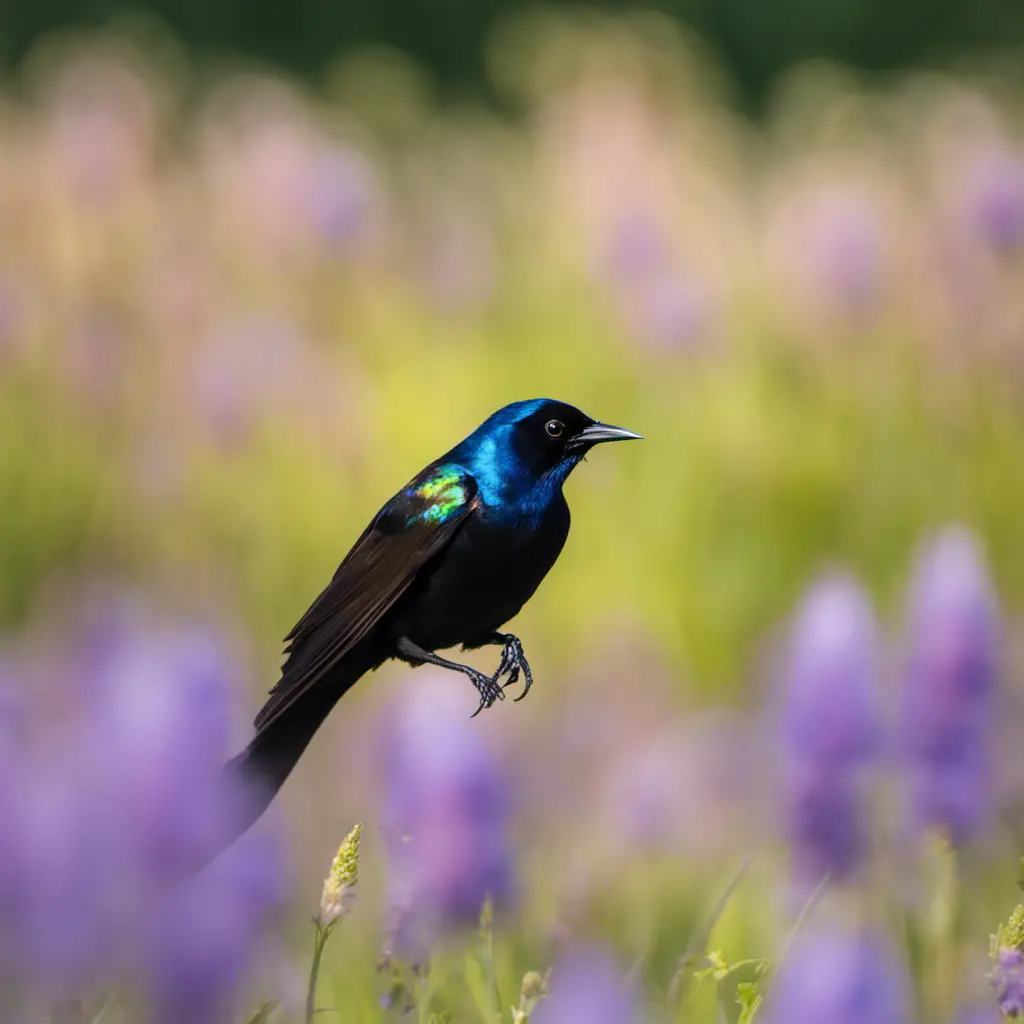
There are several species of ducks that can be found in Iowa, but the most common one is the Mallard. Mallards are known for their beautiful green heads, yellow bills, and brown bodies. They’re highly adaptable and can be found in a variety of habitats such as wetlands, ponds, and lakes. When it comes to migration patterns, Mallards are considered partially migratory. Some individuals migrate long distances to escape harsh winters, while others stay in Iowa year-round.
Mallards are also known for their unique breeding habits. They typically breed in the spring and summer months, forming pairs that last for only a single breeding season. The females build nests on the ground, usually in dense vegetation near water. They lay an average of 8-13 eggs, which hatch after an incubation period of about 25-30 days. Once the ducklings hatch, they’re able to leave the nest and swim within a day or two. Mallards are excellent parents, with the females taking care of the ducklings while the males provide protection.
Understanding the Mallard migration patterns and breeding habits is important for conservation efforts and maintaining healthy populations of these beautiful birds in Iowa.
Canada Goose
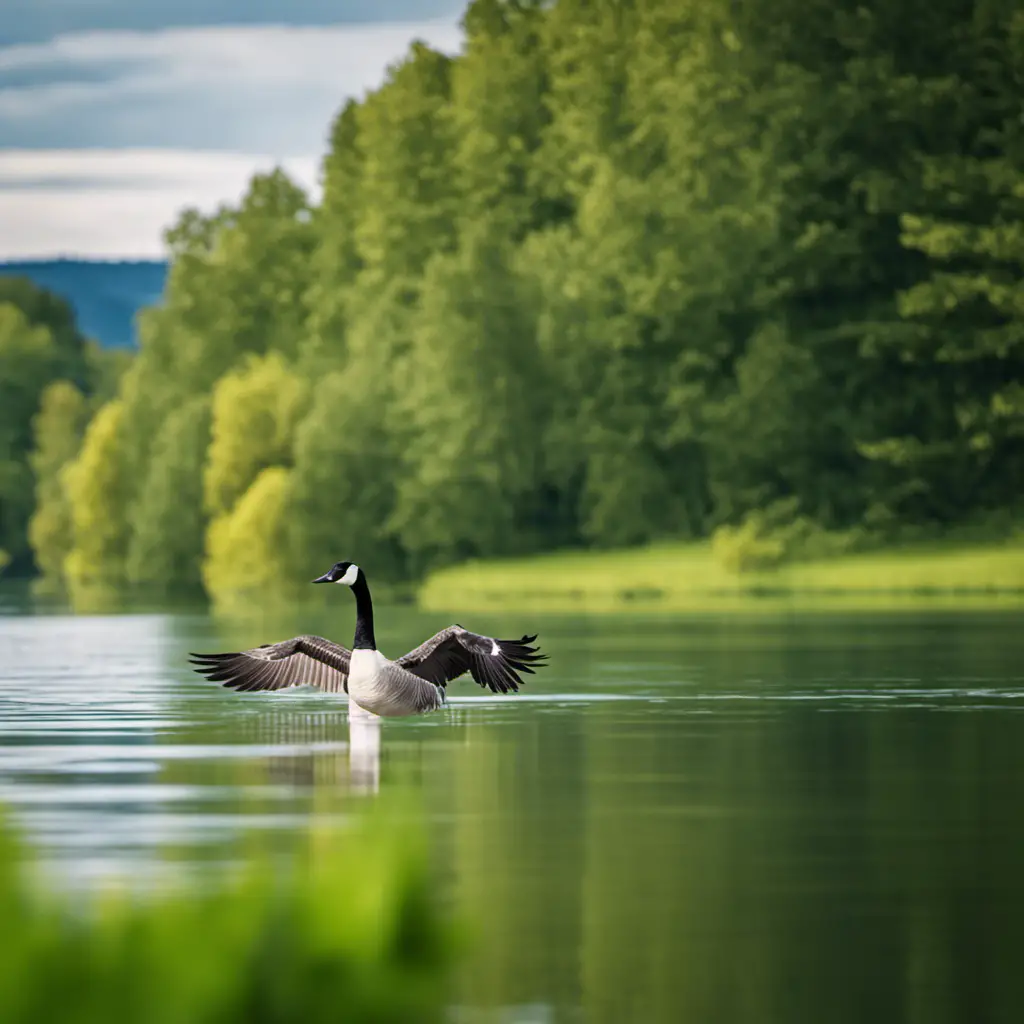
Have you seen any Canada Geese flying south for the winter?
Canada Geese are well-known for their annual migration patterns, where they travel from their breeding grounds in the northern regions of North America to warmer climates in the south. These magnificent birds have a strong instinct to seek out suitable habitats that provide ample food resources and open water for roosting and feeding.
During their migration, Canada Geese often form large flocks, flying in a characteristic V formation. This pattern helps them conserve energy by taking advantage of the updraft created by the bird in front of them.
Canada Geese are adaptable and can be found in a variety of habitats including lakes, ponds, rivers, and even urban areas. They’re herbivorous, feeding on grasses, sedges, and grains.
Understanding their migration patterns and habitat preferences is crucial for their conservation and management.
Rock Pigeon
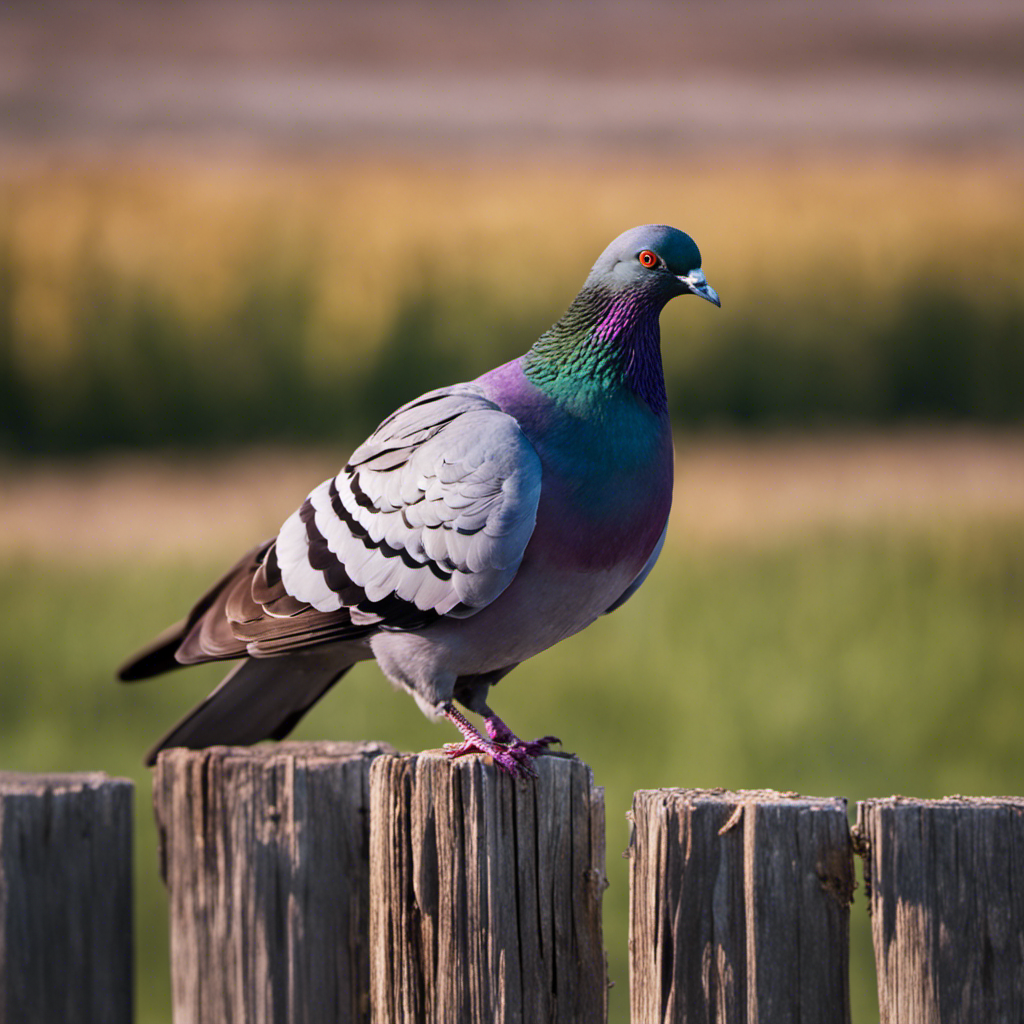
Did you know that Rock Pigeons, commonly seen in urban areas, have adapted to live alongside humans? These birds, also known as Columba livia, have developed specific behavioral patterns and nesting habits that allow them to thrive in urban environments.
Behavioral patterns:
Rock Pigeons are highly social birds, often seen in large flocks.
They’ve a strong homing instinct, enabling them to navigate back to their nests even when released far away.
Pigeons are known for their cooing vocalizations and vigorous head-bobbing displays.
Habitat:
Rock Pigeons have adapted to live in a variety of habitats, including cities, parks, and buildings.
They’re particularly drawn to areas with ample food sources, such as dumpsters and outdoor cafes.
Pigeons are excellent flyers and can easily navigate the urban landscape.
Nesting habits:
Pigeons build their nests in protected areas, such as building ledges, bridges, and tree hollows.
They construct their nests using twigs, leaves, and other available materials.
Pigeons are known to breed throughout the year, producing multiple broods.
American Crow
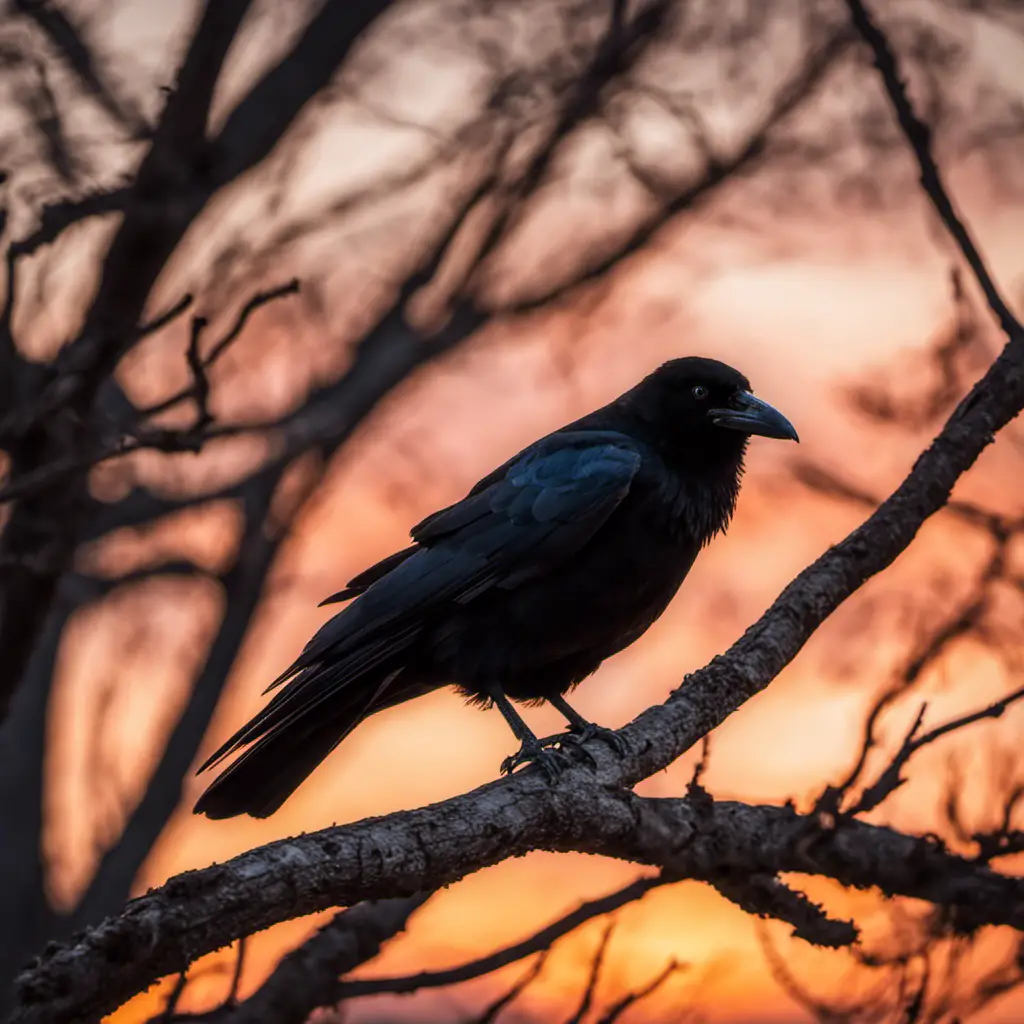
Have you ever observed the intelligent problem-solving abilities of American Crows? These remarkable birds are known for their adaptability and resourcefulness, making them one of the most successful species in North America.
American Crows can be found in a variety of habitats, including forests, fields, and urban areas. They’re highly social birds, often forming large flocks for foraging and roosting.
Their vocalizations play a crucial role in their communication, with over 30 distinct calls identified so far. These vocalizations serve different purposes, such as warning other crows of potential threats or signaling the location of food sources.
American Crows also have the ability to problem-solve, using tools to obtain food or solve puzzles.
Their intelligence and complex behavior make them a fascinating species to study and observe.
Common Grackle

Do you know that Common Grackles are known for their distinctive iridescent plumage, which shines with hues of blue, purple, and green in the sunlight? These birds are commonly found in open habitats such as grasslands, agricultural fields, and suburban areas. They’ve adapted well to human-altered landscapes and can often be seen foraging in parking lots or scavenging for food in garbage bins.
Common Grackles are highly social birds and are often seen in large flocks, especially during the non-breeding season. They communicate through a variety of vocalizations, including calls and songs.
Conservation efforts for Common Grackles focus on preserving their habitat and raising awareness about the importance of these birds in maintaining ecological balance. Efforts are also being made to reduce the use of harmful pesticides that can negatively impact their populations.
Brown-headed Cowbird
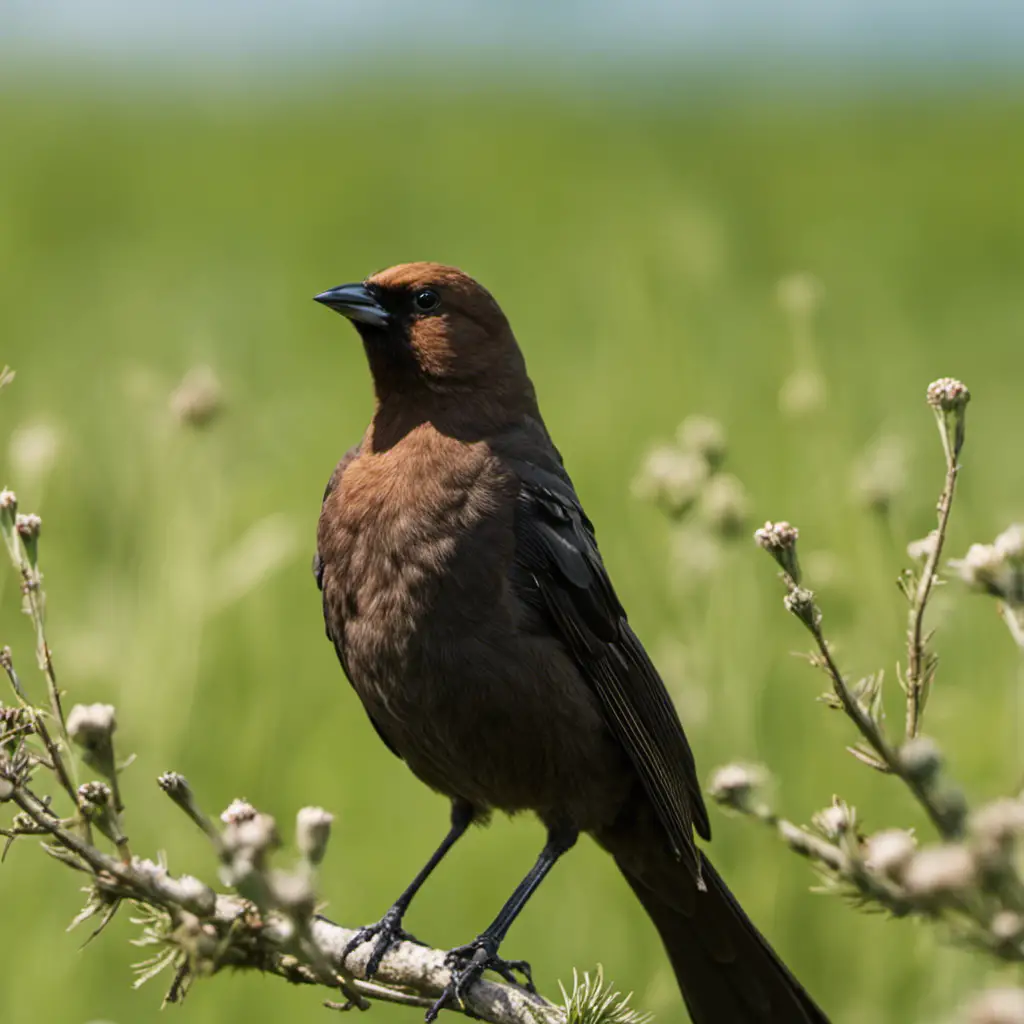
You can spot the Brown-headed Cowbird in Iowa, as it is known for its unique breeding strategy and parasitic behavior. This bird has a fascinating behavior pattern that involves laying its eggs in the nests of other bird species, leaving them to raise its young. It is a sneaky strategy that allows the Cowbird to save energy and resources for future reproduction.
The Brown-headed Cowbird is commonly found in open grasslands, agricultural fields, and woodland edges throughout Iowa. It has a diverse diet, feeding on insects, seeds, and fruits.
Here is a table that summarizes some key information about the Brown-headed Cowbird:
| Behavior Patterns | Habitat | Diet |
|---|---|---|
| Parasitic breeder | Open grasslands | Insects |
| Agricultural | Seeds | |
| fields | Fruits | |
| Woodland edges |
Understanding the behavior patterns, habitat, and diet of the Brown-headed Cowbird allows us to appreciate its unique role in the avian community of Iowa.
Song Sparrow
Can you hear the melodious song of the Song Sparrow echoing through the fields and woodlands of Iowa? These charming little birds are an integral part of the state’s ecology, contributing to its biodiversity and ecosystem health. Understanding the ecology of song sparrows is essential for appreciating their role in the natural world.
Here are some key points to consider:
Habitat: Song sparrows are found in a variety of habitats, including grasslands, wetlands, and shrubby areas.
Diet: They primarily feed on seeds, insects, and berries, adapting their diet based on seasonal availability.
Breeding: Song sparrows are monogamous and build cup-shaped nests on or near the ground, typically hidden within vegetation.
Nesting materials: They construct their nests using grasses, leaves, and twigs, lining them with feathers and soft materials.
Clutch size: The average clutch size ranges from 3 to 5 eggs.
Incubation and fledging: Both parents take turns incubating the eggs for about 12-14 days, and the chicks leave the nest after around 9-12 days.
Cedar Waxwing
You should look for a group of Cedar Waxwings, as they often gather in large flocks during the winter months. These beautiful birds can be found in various habitats across North America, including forests, orchards, and suburban areas. Cedar Waxwings are known for their distinctive plumage, with a sleek gray body, a yellow belly, and a black mask on their face. They have a unique feeding behavior, primarily consuming fruits such as berries, cherries, and crabapples. In fact, they are often seen perched on trees, plucking fruits with their sharp beaks. To understand their habitat preferences and feeding behavior, let’s take a closer look at the following table:
| Habitat Preferences | Feeding Behavior |
|---|---|
| Forests | Fruits |
| Orchards | Berries |
| Suburban Areas | Cherries |
Killdeer
Do you know where to find a Killdeer nest?
Killdeer (Charadrius vociferus) are ground-nesting birds commonly found in North America, including Iowa. To locate their nests, you should look for specific habitats that they prefer.
Killdeer prefer open areas such as grasslands, agricultural fields, and even parking lots. They often choose nest sites that are close to water sources, such as ponds or streams. Their nests are typically located on the ground and are well-camouflaged, making them difficult to spot.
In terms of behavior, Killdeer are known for their distraction displays. When a potential predator approaches their nest, they’ll feign injury or act as if they’ve a broken wing to divert attention away from their vulnerable eggs or chicks. This behavior is an adaptive strategy to increase their nesting success.
Chipping Sparrow
Have you seen the Chipping Sparrow in Iowa, and can you identify its distinctive reddish cap? The Chipping Sparrow (Spizella passerina) is a small passerine bird that can be found throughout North America, including Iowa. It is known for its reddish-brown cap, which is a distinguishing feature of the species. The Chipping Sparrow has specific habitat preferences, favoring open woodlands, parks, and gardens with scattered trees. It is commonly found nesting in shrubs or low trees. In terms of feeding habits, the Chipping Sparrow primarily consumes seeds, especially from grasses and weeds. It also eats insects and spiders during the breeding season to provide essential protein for their growing chicks. This species is a common sight in Iowa and can be easily identified by its distinctive cap.
| Chipping Sparrow | |
|---|---|
| Habitat Preferences | Open woodlands, parks, gardens with scattered trees |
| Feeding Habits | Consumes seeds, insects, and spiders |
Belted Kingfisher
Take a moment to listen to the distinctive call of the Belted Kingfisher as it perches on a branch overlooking the water. This fascinating bird is known for its unique hunting techniques and habitat preferences.
Habitat preferences:
- The Belted Kingfisher is commonly found near bodies of water, such as rivers, lakes, and streams.
- It prefers habitats with clear water and abundant fish populations.
- This bird often nests in burrows dug into riverbanks or hillsides.
Feeding behavior:
- The Belted Kingfisher is an adept fisher, relying on its sharp eyesight to spot fish from above.
- It dives headfirst into the water to catch its prey, using its long, sharp bill to grab the fish.
- It then returns to its perch to consume the fish, often beating it against the branch to ensure it’s dead before swallowing.
Understanding the Belted Kingfisher’s habitat preferences and feeding behavior provides insight into its remarkable adaptations for survival in aquatic environments.
Great Blue Heron
You should definitely observe the Great Blue Heron as it gracefully wades through the water, searching for its next meal. The heron’s behavior is fascinating to study, especially in its natural habitat.
This majestic bird can be found in a variety of wetland environments, such as marshes, swamps, and rivers, where it can easily find its preferred diet of fish, frogs, and small mammals. The heron’s long legs and neck, coupled with its sharp beak, enable it to patiently stalk its prey, waiting for the perfect moment to strike. Its keen eyesight allows it to detect even the slightest movement in the water, ensuring a successful hunt.
The heron’s habitat is crucial for its survival, as it provides both food and suitable nesting sites. By observing the heron’s behavior and understanding its habitat needs, we can contribute to the conservation and preservation of this remarkable species.
Turkey Vulture
There are two species of vultures in Iowa, but the most common one is the Turkey Vulture, which can be easily identified by its red head and wingspan of six feet. Turkey vultures are fascinating birds known for their unique feeding habits and migration patterns.
Feeding habits:
Turkey vultures are scavengers, primarily feeding on carrion.
They have a keen sense of smell, which helps them locate decaying carcasses from great distances.
Their bald head allows them to stick their entire head into a carcass without getting feathers dirty.
Migration patterns:
Turkey vultures are migratory birds, typically spending winters in Central and South America and returning to Iowa in the spring.
They follow warm air currents or thermals during migration, conserving energy by soaring rather than flapping their wings.
These birds can cover impressive distances during migration, sometimes traveling up to 200 miles in a single day.
Cooper’s Hawk
When you spot a Cooper’s Hawk in Iowa, it’s important to observe its behavior from a safe distance. Cooper’s Hawks are birds of prey that are commonly found in woodland areas across North America, including Iowa. They are known for their agility and speed, making them skilled hunters of small birds and mammals. To understand their habitat and behavior better, let’s take a look at the following table:
| Habitat | Behavior | |
|---|---|---|
| Location | Woodlands, forests, and suburban areas | Agile and swift flyers |
| Nesting | Build stick nests high in trees | Courtship displays include aerial acrobatics |
| Diet | Primarily small birds and mammals | Ambush hunters, often seen perched in trees |
Red-tailed Hawk
Spotting a Red-tailed Hawk soaring overhead can be an exhilarating experience. These majestic birds are known for their distinct red tails, which make them easily identifiable. Red-tailed Hawks are found throughout North America, including in Iowa, where they thrive in a variety of habitats.
Conservation efforts play a crucial role in protecting these raptors and their habitats. By preserving their natural habitats and promoting sustainable land use practices, we can ensure the survival of Red-tailed Hawks and other avian species.
Understanding their migration patterns is also important for their conservation. Red-tailed Hawks are migratory birds, with individuals from northern regions often flying south during the winter months. By studying their migration routes and stopover sites, we can identify areas that are critical for their survival and implement measures to protect these locations.
Bald Eagle
You should keep an eye out for Bald Eagles while hiking along the river, as they often perch high in the trees.
The Bald Eagle, or Haliaeetus leucocephalus, is a majestic bird that has been the focus of conservation efforts in recent years. These efforts have helped to restore the population of Bald Eagles, which were once on the brink of extinction.
The habitat of Bald Eagles includes rivers, lakes, and coastal areas, where they can find an abundance of fish, their primary food source. They build large nests in tall trees near the water, where they raise their young. These nesting behaviors are crucial for the survival and growth of their population.
Eastern Screech-Owl
If you look closely, you might spot an Eastern Screech-Owl hiding among the branches of the tree near the hiking trail.
These small, nocturnal birds are found in various habitats throughout Iowa, including woodlands, forests, and suburban areas.
Eastern Screech-Owls are known for their distinct vocalizations, which include trills, whinnies, and soft hoots.
They primarily feed on small mammals, insects, and occasionally birds, using their sharp talons to catch their prey.
Conservation efforts are important to protect the habitat and behavior of Eastern Screech-Owls in Iowa.
This includes preserving natural areas with suitable nesting sites, reducing habitat fragmentation, and educating the public about the importance of these owls in the ecosystem.
Frequently Asked Questions
What Is the Average Lifespan of an American Robin?
The average lifespan of an American robin is around 2 years. They are known for their migration patterns, where they travel long distances in search of food. During breeding season, they build nests and lay eggs.
How Do Northern Cardinals Communicate With Each Other?
Northern cardinals communicate with each other through a variety of social behaviors and vocalizations. They use different calls, songs, and body postures to convey messages relating to territory defense, courtship, and warning signals.
What Is the Nesting Behavior of House Sparrows?
House sparrows have interesting nesting habits. They build nests in cavities, such as trees or buildings. Their reproductive cycle is quite efficient, with females laying multiple clutches of eggs each year.
How Do Red-Winged Blackbirds Defend Their Territories?
Red-winged blackbirds defend their territories through vocal displays and aggressive behaviors. These birds use their distinctive calls to communicate boundaries and ward off intruders, often engaging in physical confrontations to protect their territory.
What Is the Diet of Mourning Doves?
Mourning doves have a diverse diet that consists mainly of seeds and grains, but they also consume small amounts of fruits and insects. Their feeding habits vary throughout the year depending on food availability.
Conclusion
In conclusion, the state of Iowa boasts a diverse array of bird species. From the iconic American Robin and Northern Cardinal to the adaptable House Sparrow and Red-winged Blackbird, these avian inhabitants enrich the local ecosystem.
The presence of predatory birds like the Cooper’s Hawk, Red-tailed Hawk, and Bald Eagle further exemplifies the balanced ecological dynamics at play.
Lastly, the Eastern Screech-Owl adds a touch of nocturnal intrigue to Iowa’s birdlife.
Overall, the bird population in Iowa is a testament to the state’s thriving biodiversity.

An avid ornithologist, zoologist and biologist with an unwavering passion for birds and wild animals.
Dr. Wilson’s journey in ornithology began in childhood and led him to obtain a Ph.D. in Ornithology from the prestigious Avian Research Institute. He has worked closely with renowned experts in the field and conducted extensive research and field studies globally.

